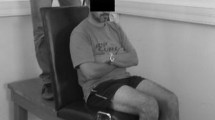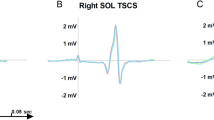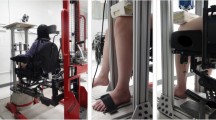Abstract
Soleus (SOL) corticospinal excitability has been reported to increase during Achilles tendon vibration. The aim of the present study was to further investigate SOL corticospinal excitability and elucidate the changes to intracortical mechanisms during Achilles tendon vibration. Motor-evoked potentials (MEPs) were elicited in the SOL by transcranial magnetic stimulation (TMS) of the corresponding motor cortical area of the leg with and without 50-Hz Achilles tendon vibration. SOL input–output curves were determined. Paired-pulse protocols were also performed to investigate short-interval intracortical inhibition (SICI) and intracortical facilitation (ICF) by conditioning test TMS pulses with sub-threshold TMS pulses at inter-stimulus intervals of 3 and 13 ms, respectively. During Achilles tendon vibration, motor threshold was lower than in the control condition (43 ± 13 vs. 49 ± 11 % of maximal stimulator output; p = 0.008). Input–output curves were also influenced by vibration, i.e. there was increased maximal MEP amplitude (0.694 ± 0.347 vs. 0.268 ± 0.167 mV; p < 0.001), decreased TMS intensity to elicit a MEP of half the maximal MEP amplitude (100 ± 13 vs. 109 ± 9 % motor threshold; p = 0.009) and a strong tendency for decreased slope constant (0.076 ± 0.04 vs. 0.117 ± 0.04; p = 0.068). Vibration reduced ICF (98 ± 61 vs. 170 ± 105 % of test MEP amplitude; p = 0.05), but had no effect on SICI (53 ± 26 vs. 48 ± 22 % of test MEP amplitude; p = 0.68). The present results further document the increased vibration-induced corticospinal excitability in the soleus muscle and suggest that this increase is not mediated by changes in SICI or ICF.



Similar content being viewed by others
Abbreviations
- I 50 :
-
Stimulus intensity required to obtain a MEP amplitude of half the size of the plateau
- ICF:
-
Intracortical facilitation
- MEP:
-
Motor-evoked potential
- MEPa :
-
MEP amplitude
- P :
-
Plateau of the input–output curve
- rMT:
-
Resting motor threshold
- SICI:
-
Short-interval intracortical inhibition
- SOL:
-
Soleus
- TMS:
-
Transcranial magnetic stimulation
- vMT:
-
Vibrating motor threshold
References
Abbruzzese M, Minatel C, Faga D, Favale E (1997) Testing for pre-synaptic and post-synaptic changes in the soleus H reflex pathway following selective muscle vibration in humans. Neurosci Lett 231:99–102
Boroojerdi B, Battaglia F, Muellbacher W, Cohen LG (2001) Mechanisms influencing stimulus-response properties of the human corticospinal system. Clin Neurophysiol 112:931–937
Carroll TJ, Riek S, Carson RG (2001) Reliability of the input-output properties of the cortico-spinal pathway obtained from transcranial magnetic and electrical stimulation. J Neurosci Methods 112:193–202
Claus D, Mills KR, Murray NM (1988) Facilitation of muscle responses to magnetic brain stimulation by mechanical stimuli in man. Exp Brain Res 71:273–278
Devanne H, Lavoie BA, Capaday C (1997) Input–output properties and gain changes in the human corticospinal pathway. Exp Brain Res 114:329–338
Giesebrecht S, Martin PG, Gandevia SC, Taylor JL (2010) Facilitation and inhibition of tibialis anterior responses to corticospinal stimulation after maximal voluntary contractions. J Neurophysiol 103:1350–1356. doi:10.1152/jn.00879.200900879.2009
Hopkins WG (2000) Measures of reliability in sports medicine and science. Sports Med 30:1–15
Kaelin-Lang A, Luft AR, Sawaki L, Burstein AH, Sohn YH, Cohen LG (2002) Modulation of human corticomotor excitability by somatosensory input. J Physiol 540:623–633
Kossev A, Siggelkow S, Schubert M, Wohlfarth K, Dengler R (1999) Muscle vibration: different effects on transcranial magnetic and electrical stimulation. Muscle Nerve 22:946–948
Kujirai T, Caramia MD, Rothwell JC et al (1993) Corticocortical inhibition in human motor cortex. J Physiol 471:501–519
Lapole T, Pérot C (2010) Effects of repeated Achilles tendon vibration on triceps surae force production. J Electromyogr Kinesiol 20:648–654. doi:10.1016/j.jelekin.2010.02.001
Lapole T, Deroussen F, Perot C, Petitjean M (2012) Acute effects of Achilles tendon vibration on soleus and tibialis anterior spinal and cortical excitability. Appl Physiol Nutr Metab 37:657–663. doi:10.1139/h2012-032
Lapole T, Canon F, Perot C (2013) Ipsi- and contralateral H-reflexes and V-waves after unilateral chronic Achilles tendon vibration. Eur J Appl Physiol 113:2223–2231. doi:10.1007/s00421-013-2651-6
Lapole T, Temesi J, Gimenez P, Arnal PJ, Millet GY, Petitjean M (2015) Achilles tendon vibration-induced changes in plantar flexor corticospinal excitability. Exp Brain Res 233:441–448. doi:10.1007/s00221-014-4125-4
Macefield G, Hagbarth KE, Gorman R, Gandevia SC, Burke D (1991) Decline in spindle support to alpha-motoneurones during sustained voluntary contractions. J Physiol 440:497–512
McNeil CJ, Butler JE, Taylor JL, Gandevia SC (2013) Testing the excitability of human motoneurons. Front Hum Neurosci 7:152. doi:10.3389/fnhum.2013.00152
Mileva KN, Bowtell JL, Kossev AR (2009) Effects of low-frequency whole-body vibration on motor-evoked potentials in healthy men. Exp Physiol 94:103–116. doi:10.1113/expphysiol.2008.042689
Perez MA, Lungholt BK, Nyborg K, Nielsen JB (2004) Motor skill training induces changes in the excitability of the leg cortical area in healthy humans. Exp Brain Res 159:197–205. doi:10.1007/s00221-004-1947-5
Ridding MC, Rothwell JC (1997) Stimulus/response curves as a method of measuring motor cortical excitability in man. Electroencephalogr Clin Neurophysiol 105:340–344
Roll JP, Gilhodes JC, Tardy-Gervet MF (1980) Effects of vision on tonic vibration response of a muscle or its antagonists in normal man. Experientia 36:70–72
Rollnik JD, Siggelkow S, Schubert M, Schneider U, Dengler R (2001) Muscle vibration and prefrontal repetitive transcranial magnetic stimulation. Muscle Nerve 24:112–115
Rosenkranz K, Rothwell JC (2003) Differential effect of muscle vibration on intracortical inhibitory circuits in humans. J Physiol 551:649–660. doi:10.1113/jphysiol.2003.043752
Rosenkranz K, Rothwell JC (2006) Differences between the effects of three plasticity inducing protocols on the organization of the human motor cortex. Eur J Neurosci 23:822–829. doi:10.1111/j.1460-9568.2006.04605.x
Rosenkranz K, Pesenti A, Paulus W, Tergau F (2003) Focal reduction of intracortical inhibition in the motor cortex by selective proprioceptive stimulation. Exp Brain Res 149:9–16. doi:10.1007/s00221-002-1330-3
Siggelkow S, Kossev A, Schubert M, Kappels HH, Wolf W, Dengler R (1999) Modulation of motor evoked potentials by muscle vibration: the role of vibration frequency. Muscle Nerve 22:1544–1548
Steyvers M, Levin O, Verschueren SM, Swinnen SP (2003) Frequency-dependent effects of muscle tendon vibration on corticospinal excitability: a TMS study. Exp Brain Res 151:9–14. doi:10.1007/s00221-003-1427-3
Wiesendanger M, Miles TS (1982) Ascending pathway of low-threshold muscle afferents to the cerebral cortex and its possible role in motor control. Physiol Rev 62:1234–1270
Ziemann U, Lonnecker S, Steinhoff BJ, Paulus W (1996a) Effects of antiepileptic drugs on motor cortex excitability in humans: a transcranial magnetic stimulation study. Ann Neurol 40:367–378. doi:10.1002/ana.410400306
Ziemann U, Rothwell JC, Ridding MC (1996b) Interaction between intracortical inhibition and facilitation in human motor cortex. J Physiol 496(Pt 3):873–881
Acknowledgments
We sincerely acknowledge Dr Léonard Féasson for conducting medical inclusions and Régis Bonnefoy for technical assistance. J.T. was supported by a doctoral research grant from the Rhône-Alpes Region. P.A. was supported by a doctoral research grant from the General Directorate for Armament, Ministry of Defence (France).
Conflict of interest
The authors declare that they have no competing interests.
Author information
Authors and Affiliations
Corresponding author
Rights and permissions
About this article
Cite this article
Lapole, T., Temesi, J., Arnal, P.J. et al. Modulation of soleus corticospinal excitability during Achilles tendon vibration. Exp Brain Res 233, 2655–2662 (2015). https://doi.org/10.1007/s00221-015-4336-3
Received:
Accepted:
Published:
Issue Date:
DOI: https://doi.org/10.1007/s00221-015-4336-3




